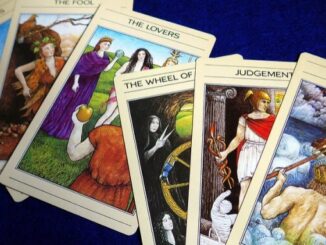
In playing games, players are constantly receiving and processing information, about the current state of the game, about the resources available to themselves, and to opponents – if the game is competitive, about strategies, rewards and countless other aspects of play. At any given moment, an item of information is either known or hidden. The central premise of many games is that this aspect need not be the same for all players at the same moment.
Information in games
There are games of ‘perfect information’. This means that at any point the state of the game, and the previous actions of all players are equally available to all players. Examples of perfect information games are Chess, Noughts and Crosses (Tic Tac Toe) and Go. There are two important things to note here. First, this is not the same as ‘complete’ information, where there is shared knowledge of how the game COULD be played, e.g. the payoff and strategies available, but not how the game has ACTUALLY been played. Second, perfect information is one thing, but how different players make use of that information is a matter of individual skill or of choices of strategy
Hidden (or disclosed) information is a much simpler concept, simply referring to the status of a particular piece of information at a given time. Games of perfect information contain information that is still hidden (for example, the future move of your opponent in Chess) it is simply that when information is disclosed, it is disclosed equally to all players.
Types of hidden information
In Characteristics of Games (Elias, Garfield & Gutschera, 2012) the authors identify three (non-exclusive) categories of hidden information.
Characteristics of Games is available on Amazon
Private – One player has access to this information and others do not. Frequently, this information is generated randomly, because if it were generated by a pre-determined process, it would not be hidden. Examples of this kind of information would be a card taken into hand by a player, or a secret goal allocated to a player at the beginning of a game (which could also be achieved by the random drawing of a card).

‘Puzzlelike’ – Many games use the discovery of hidden information as a central mechanic and player experience. Often, the game provides clues to players to guide them through the process of resolving these puzzles. Examples of this are Escape Rooms, Crosswords and current hot property, Wordle. The replayability of these examples is limited, because once you know the answer, the play is exhausted. But puzzlelike information can also be generated anew each time a game is played (causing an overlap with the final kind of hidden information – Randomness). Although you would not solve the same Wordle twice, the same experience can be repeated with a new word in 24 hours-time. Selecting from a set of face-down cards each time you play Cluedo (Clue) means that you have a new murder to solve.
Randomness – As mentioned above, randomness can be used as a way of generating hidden information. The authors of Characteristics of Games split randomness into three categories; explicit random elements, such as dice or cards, von Neumann games and human ignorance. In the case of a die roll in a game, the information is hidden from all players until it is rolled. If the result of a randomizer continues to be hidden from some players (as in drawing a card and taking it to hand), it actually generates two kinds of hidden information in the game; the uncertainty before it is drawn, and the fact that only one (or some) players have access to the information after the draw. In the case of human ignorance.
In Von Neumann games, players take simultaneous actions, which were previously unknown to each other, for example, Rock, Paper Scissors, or the action and response players of competitive sport (how will my opponent hit the tennis ball, and where should I therefore run to ensure I return his shot?). Simultaneous choices which affect outcomes of play can also occur before actual gameplay. When opponents in a Magic: The Gathering (MTG) game make choices about which cards to include in their respective decks, this information is hidden.

Human ignorance can be thought of as a form of ‘randomizer’ in the brain. It is the uncertainty about the decision a player will make because he does not have access to information which would allow him to be more informed about his choice, or he does not know how to make use of the information he does have.
Player Experience of Hidden Information
All game experiences involve hidden information, because, fairly obviously there would be no point in pursuing play if you knew exactly how it would unfold beforehand. But an analysis of player experience in ALL games would be too wide a scope for this article, so we shall look specifically at player experience in games where the discovery, or use of hidden information is a central characteristic.
Discovery as a game experience can be very motivating for particular player types, and can serve as a way of creating a sense of progress towards a goal. It is also an effective tool for the game designer to control the pace of a game. If certain actions or decisions cannot be taken until a specific piece of information is disclosed, then tight control can be exercised over the order and speed at which players use particular modes of play or encounter concepts.
A related experience is surprise, which can be an extremely pleasurable aspect of play, and be positively associated with increased engagement, if not overused.
Gameplay and Hidden Information
In games where hidden information is central, certain types of gameplay are also likely to be prevalent. Reasoning by Eliminating Possibilities to arrive at an answer is found in games like Scotland Yard, Cluedo and 221B Baker Street, and it no accident that these games are also often thematically linked to crime and detection.
Educated (or even uneducated) guesses often from part of the strategy of players when, in the absence of certain information, they still have to make decisions to continue to play. Another related effect of hidden information is that the more information that is hidden, the less reliant players can be on calculations to inform their decisions correctly.
Unequal access to information facilitates bluffing gameplay. Indeed several gambling games rely on this to create the central game experience. The standout example of this would be Poker.

Although, as established above, hidden information is often implemented through randomness, and has a lot in common with randomness in terms of its effects on gameplay, hidden information can also increase the need for, and the inherent advantage in, skilful play. Most obvious would be the possibilities for using (and developing greater) skill in using the information as it becomes disclosed, but in many games, players can also prevail by developing strategies for discerning information that is still hidden but can be inferred from other already disclosed information. More details of these skills can be found in Player Strategies, below.
Player types
If we look at a few of the widely used player type frameworks we can see player types for whom the discovery of hidden information would be particularly motivating. In both the Richard Bartle Player Types and in Andrzej Marczewkis’ Hexad (which builds on Bartle), these are known as Explorers. In the Hexad, Explorers are a sub-type of ‘Free Spirit’, a player type which values autonomy in their experience of play. The Explorer (in both frameoworks) wants to poke about in your game, discovering Easter Eggs and other delightful surprises, as well as probing the limits of the gameworld that has been created for them.
Yu-kai Chou’s Octalysis framework does not have a built-in player type framework of its own. Previously, designers would use Bartle or Marczewski with Octalysis to inform their design choices. More recently, the Octalysis design process requires designers to create and describe their own player types, relevant to the particular application in question by using two continuum lines to create four quadrants, and appropriately naming the segments of your player cohort which fall in each quadrant.
As you obviously have free rein to include whatever aspects you wish in this framework, they may, or may not have anything to do with desire (or disinterest) in discovery of information, but here are a couple of examples where you might consider the use of hidden information in a gamification application, having identified player types for whom this might apply.
Player Strategies and skills
Strategies and skills which players can adopt to be successful in games of hidden information fall into two main categories; those which seek to reduce the amount of information which is hidden from them, and those which aim to mitigate the effects of uncertainty where certainty cannot be gained. Some of the former are so effective that they have been made illegal in the rules of various games, for example, card counting in many gambling games. But if players can train themselves to remember and read game states using only their brain, and no external help, they can vastly improve their chances of becoming an expert player, in games like Bridge.

Eliminating Possibilities until only the correct solution remains occurs in many games. Basic players will exclude possibilities which are explicitly revealed to them, but skilful players will consider all relevant information and rules in the game space to allow them to eliminate a greater number of options when presented with information, maybe by linking it with a previous piece of information, or relating it to the characteristics of the game space as a whole. For example, in a fictional murder mystery game set in early 19th Century London, I have been shown the alibi of Lord Felthrop, so I can definitely cross him off the list of murderers, but I have also discovered that the murderer was once a Member of Parliament, which will also (at this point in history) allow me to exclude all women and men who are not landowners. Likewise, because Battleships requires that no ships can touch, you can ‘rule out’ one space around each ship once you have sunk it.
Chance and Uncertainty
Returning to the theme of chance, knowledge of the available resources in a game (e.g. the letter distribution in scrabble, the number of faces of a die etc.) will also allow me to use probability as a potential way making educated guesses as to what might happen next.
Other skills are about dealing with the effects of uncertainty, rather than reducing the uncertainty itself. Inevitably, if you make decisions based on less than perfect information, some of those decisions will not go as planned, so another skill often required in games of hidden information, is the ability to plan ahead for contingencies if things go wrong – to leave as many potential favourable decision routes open as you can, until you are forced to shut them down, or the right solution is arrived at. For example, thinking carefully about discards in a trick-taking card game, to ensure that you are not forced later to make plays you do not wish to.
Game examples
Interesting examples of implementation of gameplay based on hidden information include:
Bridge – There are several conventions that are established to allow partners to communicate with each other, codes that reveal the distribution and value of a partner’s hand through ‘bids’ before the playing of tricks begin. This encoded communication can continue between the partners who are Defenders (not playing for a contract), as even the cards played can be informational. All players have sight of the ‘Dummy’ hand once play begins, and the Declarer therefore has total information about all the cards within the partnership.

Mastermind and Wordle – Very similar ‘codebreaking’ games in which a useful strategy is to ‘move further away’ from the likely solution in order to gain more information. For example, in your first Wordle guess you have established two letters, one correctly placed. Instead of entering a potential solution as your next word, you should enter a word with neither of the discovered letters as this will best help you rule out (or in) more letters. You will never achieve fast solutions in this way, but you are more likely to achieve more successful solutions in the long run.
Secret Hitler – Hidden roles (or goals) and social deduction go together like gin and tonic. Frequently, hidden roles or goals are known only to those who hold them, but in this case, the player who is ‘Secret Hitler’ is known to himself, but also the Fascists who wish to elect him Chancellor (to win the game for their side), but is himself unaware of who his or detractors are amongst the other players.
Application to learning outcomes and use cases
There are numerous other ways in which hidden information can be implemented in games, but to round off this article, let’s look at the ones covered above and how they might map to specific learning outcomes and use cases.
In life as in games we are very often dealing with hidden information and one very obvious use case for games-based learning focusing on hidden information is business decision-making under uncertainty. This could be because the information will be derived from an event that has not yet happened (external factors), or because there is private information held by others (competitors, other team members), which we are not privy to.
Randomness often gets a bad press, as being the ‘opposite’ of skill, but randomness as a generator of hidden information is a very good way of representing how external factors can impact strategic planning and decision-making. Dealing with surprise and the failure of planning allows learners to practice skills in contingency planning, learning from failure and operating in a VUCA world.
Puzzles in Problem Solving
Puzzlelike hidden information games are very applicable to training in problem-solving, process improvement, or in technical skills among other areas. DragonBox was a popular and very successful training game for children in solving puzzles of equality, which were actually disguised mathematical equations. Escape rooms are now often used as a way of ‘gamifying’ learning, but many of these are just wrappers for e-learning, requiring people to answer quizzes correctly to open up a new module. This structure could more properly be used if it were properly thematically linked to outcomes.
One simultaneous action that often features in business games is the Auction, which could relate to an actual series of bids to purchase (or tender for work), or could be abstracted outside of numerical values – for example, some other form of simultaneous decision-making, which results in a ‘winner’. The auction is a form of von Neumann game.
Human ignorance can be manufactured in learning games, simply by withholding information from players, and, of course, the uncertainty derived from the ignorance will itself manufacture further uncertainty (about the decisions that players will make). Such gameplay is very useful in creating learning experiences around process improvement, innovation and problem-solving.
Multiple Ways of Using Discovery
Discovery as central mechanic generally has two flavours, discovery of some previously decided ‘right’ answer or learner-led exploration which results in new information that did not exist before. An example of this might be the use of Lego® Serious Play® to explore the dynamics and culture of an organisation. The former is a trivial use of games in learning, and probably does nothing more than ‘dress up’ already accepted wisdom with a veneer of play, usually for ‘engagement’ purposes.

The Escape Room is a classic example of Discovery as pace-setter. Until you unlock the previous puzzle you cannot access the next learning/puzzle combination. Again, without a strong thematic reason to use an Escape Room, this structure can often be a trivial use of games in learning, but the careful pacing of information disclosure is important in games-based learning design, and is related to fundamental learning principles such as differentiation and scaffolding to support sequences of learning.
Eliminating Possibilities is frequently used in games of hidden information, and along with other forms of reasoning, can form part of learning experiences around thinking skills, such as critical thinking, systems thinking and creative problem solving.
Preparing Learners for Dealing with the Unknown
Decision-making in organisations and businesses cannot always rely on appropriate information being available, and over reliance upon ‘fact-based’ frameworks in such situations can cause inertia, where decision makers never feel they have reached the stage where they ‘know enough’. Potentially worse than inertia is an insistence on making decisions using ‘calculation’ methods regardless of the quality of data available. Hidden information games can form the basis of explorations of alternative decision-making strategies.
Hidden information and its many implementations are a very useful tool for the games-based learning professional for a variety of learning applications. It also has the advantage of being relatively easy to implement, particularly through randomisers such as cards, and of being a creator of engaging gameplay beyond its application to specific learning outcomes.
- James Bore – The Ransomeware Game - 13th February 2024
- Ipsodeckso – Risky Business - 23rd January 2024
- Review – Luma World Games - 15th December 2023





Be the first to comment